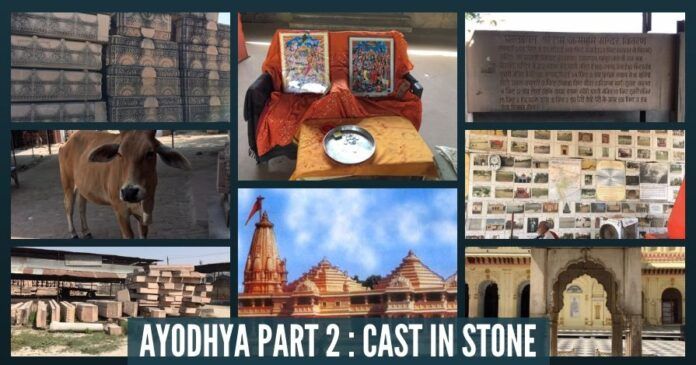
Part 1 of this series can be ‘accessed’ here. This is Part 2.
To develop my understanding of the importance of Ayodhya, a return visit reunited me with my young friend Ravi Naimish, an extraordinarily good guy and guide. It was also an honour for me that my great friend Lakshmi Bayi Nalapat wanted to revisit Ayodhya after a period of nearly 30 years. Lakshmi is not only the XIIth Princess of Travancore (erstwhile Kerala and a tranche of Tamil Nadu) but she is also India’s unique Princess of Hinduism; for most of her adult life, Lakshmi has been sitting at the feet of the learned. Her encyclopedic miscellany of spiritual knowledge and her way of sharing it so unpretentiously, rather like a bedtime story has hugely influenced my thinking. Much of my reading about Ram has been suggested by and some gifts from Shri Subramanian Swamy.
Ravi, Lakshmi and I journeyed from Lucknow past lush green crops of paddy, papaya and bananas. Ayodhya means “the place that was never conquered” or “the enemy cannot win” depending on the interpreter. Arriving in the holy city we headed straight for a chat with Shri Trikolinath Pande, who introduces himself as “Ram Lalla’s representative in the Supreme Court”. Certainly, Mr. Pande has extensive knowledge of the literary evidence of the existence of a Temple at the site of Ram’s birthplace. Pande knows there has been a Temple here since 1528; indeed the French Priest named T. Thiller documented this in his travel diaries of 1740. Pande informs us that Shaivites and Vaishnavites are in harmony over the construction of a Ram Mandir, for which the Shilanyas/foundations were laid by Kameshwar Chaupal on 9th November 1989, this was a break in tradition as Chaupal is not a Brahmin. As another example of the desire to create a Ram Mandir for all Pande relates how Princess Mirabhai of Mewar chose Ravi Das Mochi, a carpenter, as her Guru.
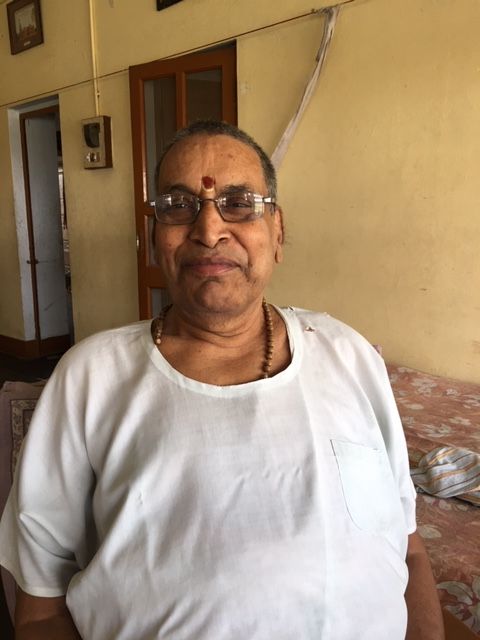
Pande suggested we visit the Nirmani Kaaryashaala/ workshop, Ramkot, Kanak Pavan/ Sita’s Palace, Hanuman Garhi Temple, and the Sarayu River.
We give him grateful thanks and onwards go to the Shri Ram Bhoomi Nayas where the bricks and stones for the Ram Mandir are stored. This is a large enclosure open to the public, there are leaflets at the gate, devotees chanting before a shrine and lots of folks willing to share information. There are towering piles of various shaped stones and bricks to build the Ram Mandir designed by the architect Chandra Bhanu Sompura, whose grandfather designed Somnath Temple. The building materials are 70% complete and the curved or carved stones are tidily stacked, in fact, the premises are immaculate and well organised. Touchingly each brick in the wall is autographed with the name of Ram. We were told there is a marble dust model of the temple made in 2001 by artisans from Gujarat, but we most admired the Sandalwood model provided by the architect. This Temple will be built in the tradition of four parts, it is the Sanctum Sanctorum and Gopuram that is the 30% not yet made. Ultimately the finished Temple will be consecrated by a Saint chosen by devotees.

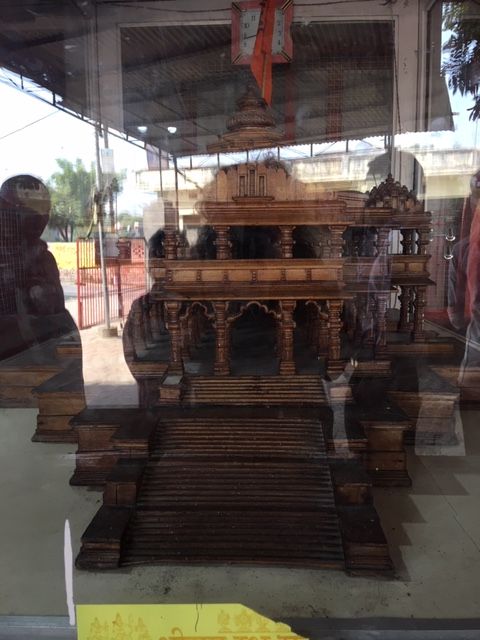
At the Shri Ram Bhoomi Nayas there is a program of the October Pujas: Nagara Sankeertana & Sarayu River Puja twice daily, Gaja- Gomata- Aswa- Kurma-Rushi- Brahmana- BrahmanaBala- Suwasini Pujas twice daily, Chaturveda Homans 7am to 12am, Ramayana Parayanam in all Indian Languages everyday from 8.30am to 12.30pm and Sri Seetarama Kalyanam everyday by 4pm.
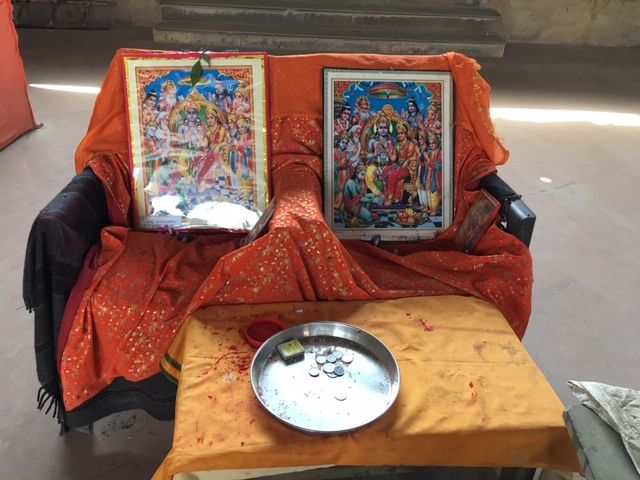
Before closing time we stopped at the Kanak Bhavan/the Golden Residence that is the palace given to Sita by Kaikeyi, wife of Dasharatha when she married Ram; it is newly painted in a golden yellow to match the grandeur of its name. There is a bitter irony in Kaikeyi’s gifting of the Kanak Bhavan, as it was Kaikeyi who took the palace away when she banished the newlyweds after Dasharatha’s death. In the courtyard there is a shrine with the imprints of the feet of Ram, this is symbolic of the stone from which Ram bounced into the chariot that took him into the forest for his fourteen years of banishment. I gave a special prayer to these imprints as it is my wish to document his footsteps.
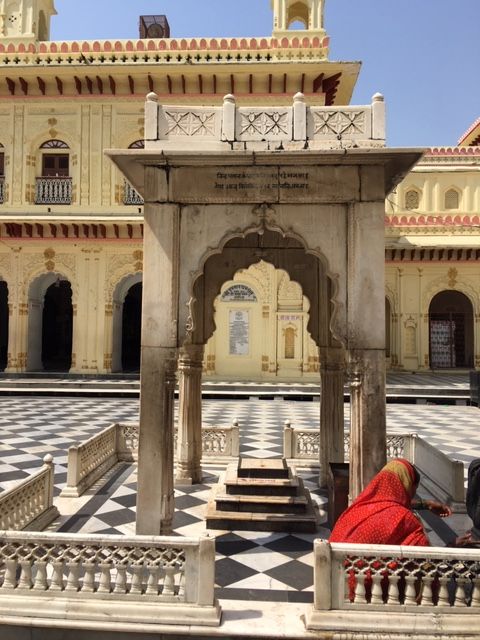
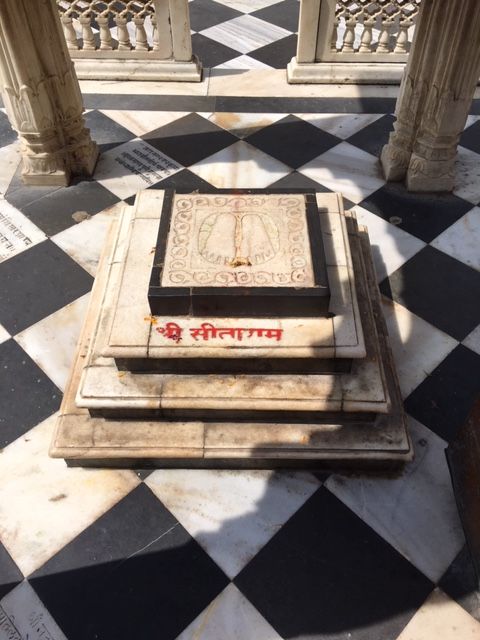
Our next stop was Ramkot, Ravi can find his way there blindfolded he has visited so often; there are many dwellings on the way where chants to Ram are heard routinely on a 24hour basis. I have related my 2016 experience in Part 1; this time it was hardly different but less hot, there were more women security guards and the prasad was a better quality containing coconut slices, dried papaya, sultanas and real sugar crystals not just processed sugar balls.
At 3 pm we checked out the brand new local hotel for possible future accommodation and then ate our packed lunch in the car.
Just a nota bene that all the above is based mostly on conversations in Hindi kindly translated by friends or volunteers locally, if I have inadvertently lost or misunderstood the meaning of anything I proffer my sincere apologies.
To be continued….
Note:
1. Text in Blue points to additional data on the topic.
2. The views expressed here are those of the author and do not necessarily represent or reflect the views of PGurus.
- Dr Swamy takes on China, its bullish attitude and how to dish it back to them - May 6, 2021
- Swamy to restore just 2 more temples against 40k destroyed by Mughals - February 19, 2021
- Let’s talk about Democracy - February 3, 2020

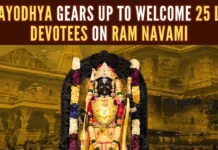
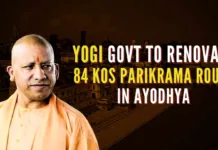
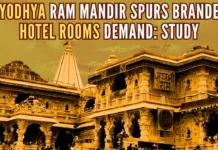







[…] 1 of this series can be ‘accessed ‘ here. Part 2 of this series can be ‘accessed ‘ here. Part 3 of this series can be ‘accessed ‘ here. Part 4 of this series can be […]
[…] பாகம்Part 1 , இரண்டாம் பாகம் Part 2 மற்றும் மூன்றாம் பாகங்களை Part 3 இங்கு […]
[…] 1 of this series can be ‘accessed ‘ here. Part 2 of this series can be ‘accessed ‘ here. Part 3 of this series can be ‘accessed ‘ here. This is Part […]
[…] 1 of this series can be ‘accessed ‘ here. Part 2 of this series can be ‘accessed ‘ here. This is Part […]